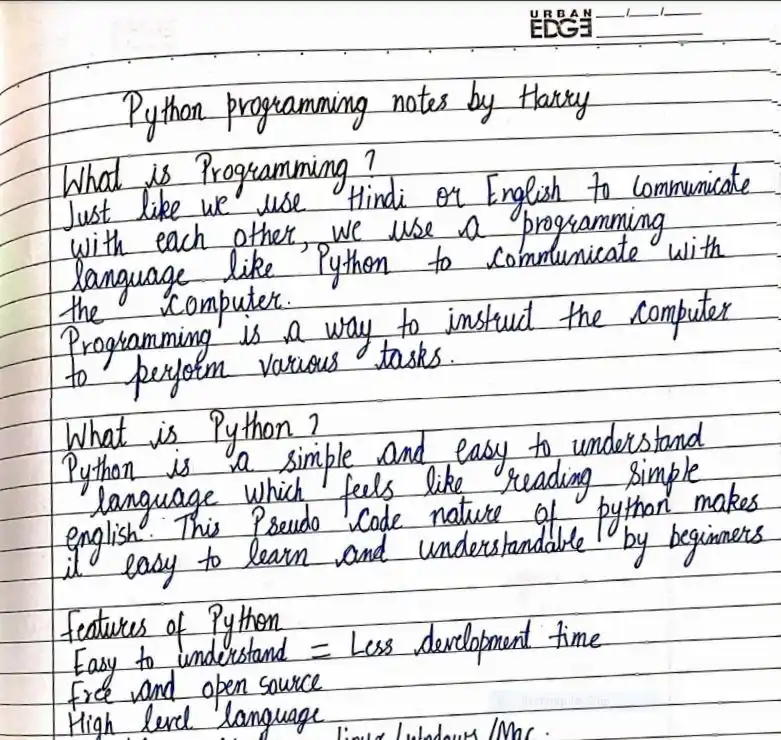Python Notes Pdf
| PDF Name | Python Notes Pdf |
|---|---|
| No. of Pages | 64 |
| PDF Size | 26.1MB |
| PDF Category | Notes |
| Last Updated | September 18, 2024 |
| Source / Credits | Codewitharry |
| Comments ✎ | 0 |
| Uploaded By | Stephen |
Introduction to Python Notes PDFs

Python is one of the most popular programming languages in the world today, widely used for web development, data analysis, machine learning, and automation. Keeping structured and accessible notes while learning Python is key to mastering its features. A great way to organize your notes is by creating them in a PDF format, which ensures they are easy to share, print, and review.
In this article, we will guide you through the process of creating effective Python notes and exporting them into PDF format.
Why Take Python Notes?
Taking notes while learning Python or any other programming language has several benefits:
- Reinforcement of Learning: Writing down concepts helps reinforce your understanding of Python syntax and libraries.
- Reference for Future Projects: Well-structured notes provide a reference guide when building future Python projects.
- Problem-Solving Guide: Notes can serve as a troubleshooting guide when debugging Python code.
- Organized Review Material: notes are excellent for revision before exams, coding interviews, or even when contributing to open-source projects.
Essential Topics for Python Notes
When creating this notes, make sure to cover the most essential topics:
- Python Basics:
- Syntax, variables, and data types (int, float, string, list, dictionary).
- Control flow (if statements, loops).
- Functions and lambda expressions.
- Object-Oriented Programming (OOP):
- Classes and objects.
- Inheritance and polymorphism.
- Encapsulation and abstraction.
- Modules and Libraries:
- Using Python’s built-in libraries like
os,sys,math, andrandom. - Third-party libraries like
numpy,pandas, andmatplotlib.
- Using Python’s built-in libraries like
- File Handling:
- Reading and writing files in Python.
- Exception handling and context managers.
- Advanced Topics:
- List comprehensions.
- Decorators.
- Generators and iterators.
- Data Structures and Algorithms:
- Understanding data structures like lists, tuples, and sets.
- Implementing algorithms such as sorting and searching.
How to Create Notes Effectively
1. Organize by Topic:
Divide your notes into sections based on Python topics such as syntax, loops, functions, or OOP concepts. This helps in easy navigation.
2. Include Code Snippets:
Whenever you discuss a concept, include small code snippets to demonstrate the functionality. For example:
pythonCopy codedef greet(name):
return f"Hello, {name}!"
print(greet("Alice"))
This helps visualize how code works in practice.
3. Use Diagrams and Flowcharts:
For complex topics like classes, inheritance, or recursion, use diagrams to make the notes more illustrative. Tools like Lucidchart or even hand-drawn diagrams work well.
4. Add Comments and Explanations:
In your code snippets, include comments explaining why a particular line or function is used.
pythonCopy code# This function calculates the factorial of a number
def factorial(n):
if n == 0:
return 1
else:
return n * factorial(n-1)
5. Highlight Important Concepts:
Use bold text, bullet points, or headers to emphasize key points, such as common errors or syntax rules.
6. Review and Practice:
Ensure that your notes are updated with the latest Python features and conventions. Regularly review your notes and practice coding to reinforce the concepts.
Chapter Wise Python Notes PDF Download Free
Download Chapter Wise Python Notes PDF for free, covering all essential topics from basics to advanced. Perfect for quick revision and mastering Python easily!












